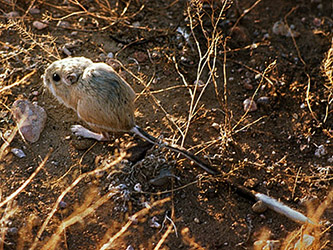Is leaving home the best choice for kangaroo rats?
12-16-2013

"During spring and summer breaks over nearly three decades, Prof. Peter Waser took our students to a 1,000 acre study site in SE Arizona to census a hamster-sized desert rodent: the banner-tailed kangaroo rat. Like most animals, young kangaroo rats leave home ("disperse") as they reach maturity, and Prof. Waser's lab used them as a model system to ask why.
In a paper published this year in the journal Ecology, Prof. Waser (with co-authors Krista Nichols and Jarrod Hadfield) showed that dispersal turns out to be a risky business. Using new statistical techniques to construct a pedigree for nearly 2,000 animals, they show that juveniles that leave home are as much as four times as likely to die during their first year, and gain no advantages later in life. The results reject one traditional explanation, that dispersers gain a fitness advantage by avoiding inbreeding. However, they are consistent with the idea that natural selection favors dispersal through its "indirect" fitness effects, by reducing competition among siblings. Prof. Waser, now retired, continues to monitor kangaroo rat populations in his spare time.
Publication: Waser, P. M.; Nichols, K. M.; Hadfield, J. D. 2013. Fitness consequences of dispersal: Is leaving home the best of a bad lot? Ecology 94: 1287-1295."